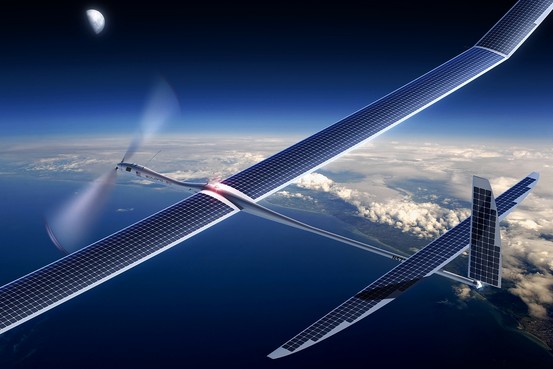Google, the ad-driven search giant, and Facebook, the social connections giant, are fighting over airplane drone technology companies. What’s that all about?
Solar-powered drones would, when they’re ready for mass-market in the next five years, be able to fly for weeks or months. They can take 2D and 3D photos resulting in better and more up-to-date maps. And they could serve as aerial Internet connections. It’s the latter that got my attention because it threatens the status quo in developed nations and opens new markets in developing nations.
Aerial Internet Drones (AIDs) suggest a breakout technology that solves — or at least remediates — the “wireless everywhere” mantra of the past decade. In developed countries such as the United States, intractable wireless problems include inadequate wireless bandwidth in high device areas (e.g., mid-town New York) necessitating more cell towers and greater slices of the electromagnetic spectrum. Moreover, “poor wireless coverage meets not-in-my-neighborhood” and inadequate capital make it politically and economically difficult to add enough cell towers to guarantee wireless broadband such as LTE to build a superior wireless broadband network in suburban and rural areas.
In underdeveloped geographies, which represent attractive new markets for the global technology and wireless companies, inexpensive and inadequate mobile broadband infrastructure creates a chicken-and-the-egg problem.
So, the vision to solve both developing and developed wireless broadband demand is to put up a global network of drones that serve as radio relays for wireless Internet connections. AIDs would be a new form of Internet router, loitering around a more-or-less fixed point in the sky.
At the right altitude, an AID has better line-of-sight than a cell tower located over the hill. The AID theoretically offers greater geographic coverage and often better signal quality than today’s cell tower networks. At a cost of less than $10 million per equipped AID, my envelope calculations suggest AID network costs compare favorably with cell towers for comparable geographic coverage.
In developing areas such as Africa, an AID network is a solution to creating metro- and rural-area Internet wireless infrastructure rapidly and without the difficulties of building land-line-connected cell towers.
Cellphone networks connect cell towers with land line connections to each other and to an Internet wired backhaul. An AID network needs to connect wirelessly to a) client cellphones and the Internet of Things and b) to a radio ground-station connected to an Internet wired backhaul. The radio ground-station is the crux of the difficulties I foresee.
The ground-station requires radio spectrum to communicate up to and down from the AID network. It represents a new demand on the over-burdened and highly political use of the electromagnetic spectrum. Where does the spectrum come from, whose ox is gored, and how are the skids greased? Think lobbying.
Moreover, the incumbent cable and wireless ISPs (i.e., Comcast, Verizon, AT&T, Sprint, Dish, et al) are not likely to give up their near monopolies on Internet access by devices, homes, and businesses without a knockdown, drag-out political fight followed by years of litigation.
Add citizen privacy related to drone picture taking to this highly volatile Internet-industrial-complex wireless food fight and you can expect great spectator sport. Although in developing countries, the issue will be described as “drone spying by the NSA”.
Like many, I would greatly appreciate and even pay more for better wireless coverage and higher wireless device bandwidth. First, Google and Facebook have to solve the real technology problems of getting the AIDs into the sky. Second, they have to muscle a (much needed) rethink of wireless spectrum use and the roles of future ISPs through the political sausage factory, and nail down the new spectrum they need. Combined, this is a heavy lift.
So, with a sigh of regret, I suspect it will be quite a while before I can say “My ISP is a Solar-Powered Drone.”
Follow me on Twitter @PeterSKastner.
Titan Aerospace/Associated Press

